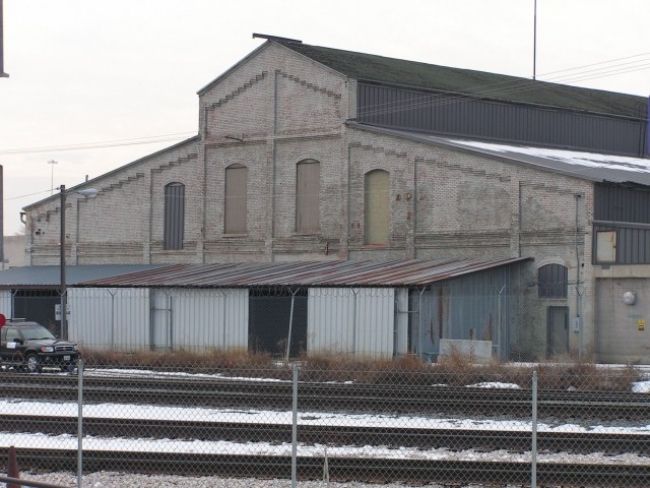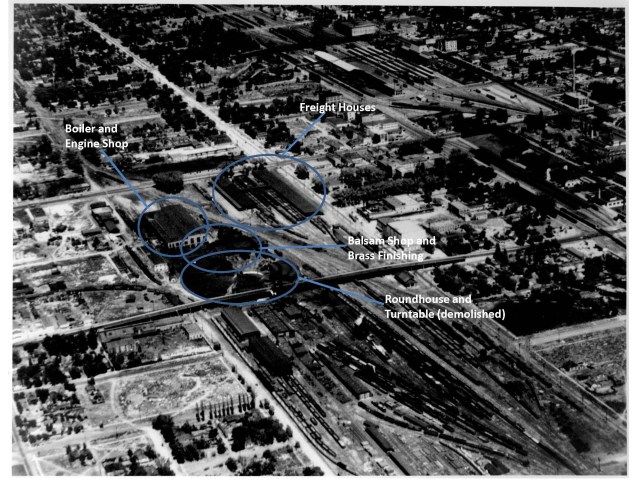History
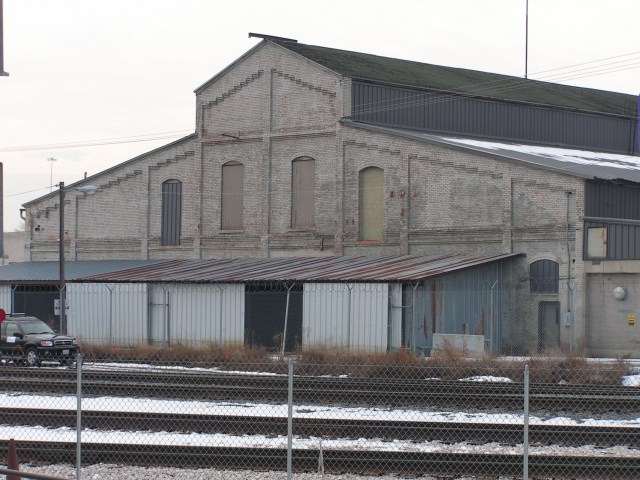 As the railyard site for the Denver & Rio Grande Railroad, this area came to include a boiler/engine shop, balsam shop, round house and turntable, and two freight houses, all built c. 1910 (see historic photo at end; Courtesy Utah State Historical Society). These buildings were still present as late as 1951 when the railroad still played a prominent role in local and regional transportation networks. However, today, only one freight house (now divided into north and south sections) and the boiler/engine shop (left and bottom) remain.
As the railyard site for the Denver & Rio Grande Railroad, this area came to include a boiler/engine shop, balsam shop, round house and turntable, and two freight houses, all built c. 1910 (see historic photo at end; Courtesy Utah State Historical Society). These buildings were still present as late as 1951 when the railroad still played a prominent role in local and regional transportation networks. However, today, only one freight house (now divided into north and south sections) and the boiler/engine shop (left and bottom) remain.
Preservation Issues
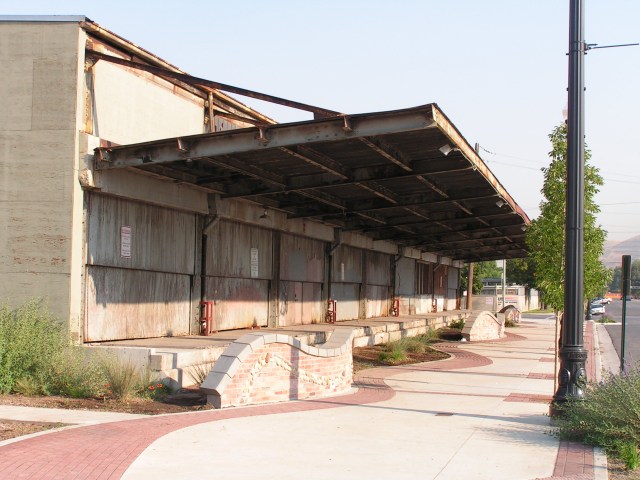 Salt Lake City and historic preservation entities (the Utah State Historic Preservation Office and Utah Heritage Foundation) agreed in 2000 through a Memorandum of Agreement that the remaining Freight House would be rehabilitated as the Intermodal Hub. Now known as Salt Lake Central Station, the historic building has been cut into two sections – north and south – creating an adverse effect to the historic character of the building. Many of the character-defining features of the south building have been renovated in the first phase of hub development, such as the clerestory windows above the wide overhanging dock, loading bays (which now appear as a series of window openings), and the exposed interior structural steel truss system.
Salt Lake City and historic preservation entities (the Utah State Historic Preservation Office and Utah Heritage Foundation) agreed in 2000 through a Memorandum of Agreement that the remaining Freight House would be rehabilitated as the Intermodal Hub. Now known as Salt Lake Central Station, the historic building has been cut into two sections – north and south – creating an adverse effect to the historic character of the building. Many of the character-defining features of the south building have been renovated in the first phase of hub development, such as the clerestory windows above the wide overhanging dock, loading bays (which now appear as a series of window openings), and the exposed interior structural steel truss system.
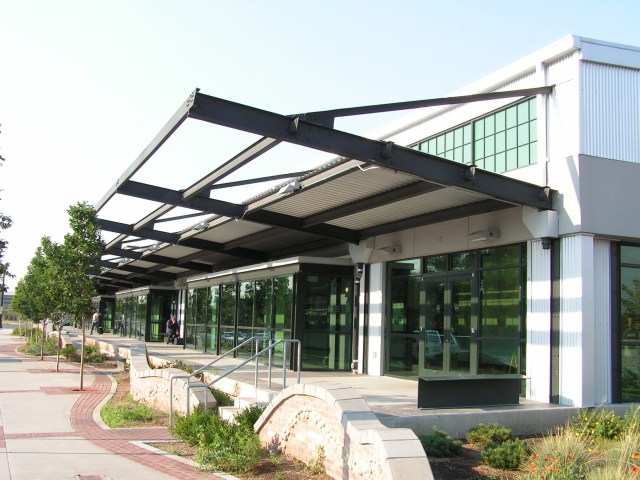 While the south building is actively used, the north building lies in wait for a new use. It remains in original condition but is neglected with deferred maintenance. Its owner, the Utah Transit Authority, has submitted a demolition application for the building but has been in negotiations with Salt Lake City Corp. regarding long range plans for the building as well as how their uses may fit into the entire UTA property and redevelopment of the Westside of downtown Salt Lake City.
While the south building is actively used, the north building lies in wait for a new use. It remains in original condition but is neglected with deferred maintenance. Its owner, the Utah Transit Authority, has submitted a demolition application for the building but has been in negotiations with Salt Lake City Corp. regarding long range plans for the building as well as how their uses may fit into the entire UTA property and redevelopment of the Westside of downtown Salt Lake City.
In addition, UTA has formally studied the area west of the tracks as a new site for bus storage. This study did not request that the two historic buildings, the Boiler/Engine Shop, be studied for reuse on the site. Therefore, they are being programmed for demolition. Utah Heritage Foundation believes that these buildings are visible and identifiable links with the railroad’s past that can continue to be used with UTA’s present needs. Besides bus storage sites, UTA is also considering several site development options for mixed-use development, which industrial buildings frequently present flexible opportunities for reuse.
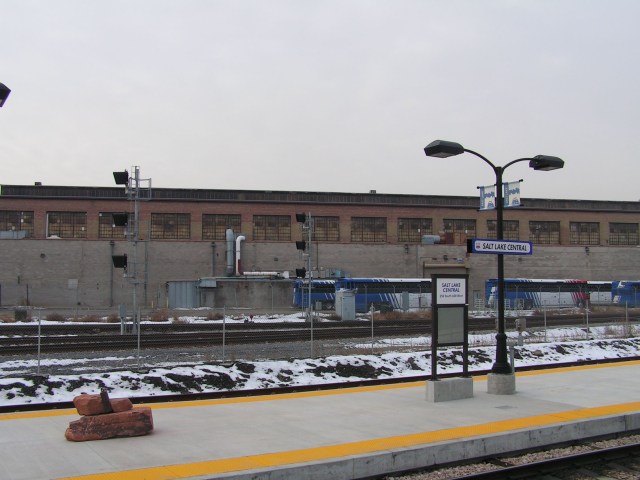 Recognizing that many people will want to live and/or work near transportation options in the near future, these indisposable structures on the Westside deserve consideration in long-range planning as options to blend with new structures, making the Gateway Neighborhood truly distinctive. Demolishing these building or replicating them, will not create an authentic experience.
Recognizing that many people will want to live and/or work near transportation options in the near future, these indisposable structures on the Westside deserve consideration in long-range planning as options to blend with new structures, making the Gateway Neighborhood truly distinctive. Demolishing these building or replicating them, will not create an authentic experience.
What you can do:
1) Write to UTA Director John Inglish and let him know that these buildings are crucial for the Westside of Salt Lake City, and that UTA should adhere to their environmental policy to reduce, reuse, and recycle materials through historic preservation.
John Inglish, Director
Utah Transit Authority
3600 South 700 West
Salt Lake City, UT 84119
2) Email Salt Lake City Mayor Ralph Becker and let him know that the city’s partnership to with UTA and historic preservation organizations is crucial to seeing that these important structures are adaptively reused and integrated into the Westside’s development, and that without them the Gateway Neighborhood does not become a unique destination to live in or visit for residents, commuters, or visitors.
3) Share your memories and thoughts of this important place with us through our Facebook page.
For more information:
Read Kirk Huffaker’s editorial “UTA needs to get onboard with Preservation” from the Salt Lake Tribune, December 13, 2009

